Enterprise Risk Management, Self-Organization, Networking and Financial Performance in Australia Private Procurement Contracts
Added on 2023-01-19
181 Pages55545 Words26 Views
Dissertation
(Enterprise risk management, self-organization,
networking and financial performance in Australia
Private procurement contract)
(Enterprise risk management, self-organization,
networking and financial performance in Australia
Private procurement contract)
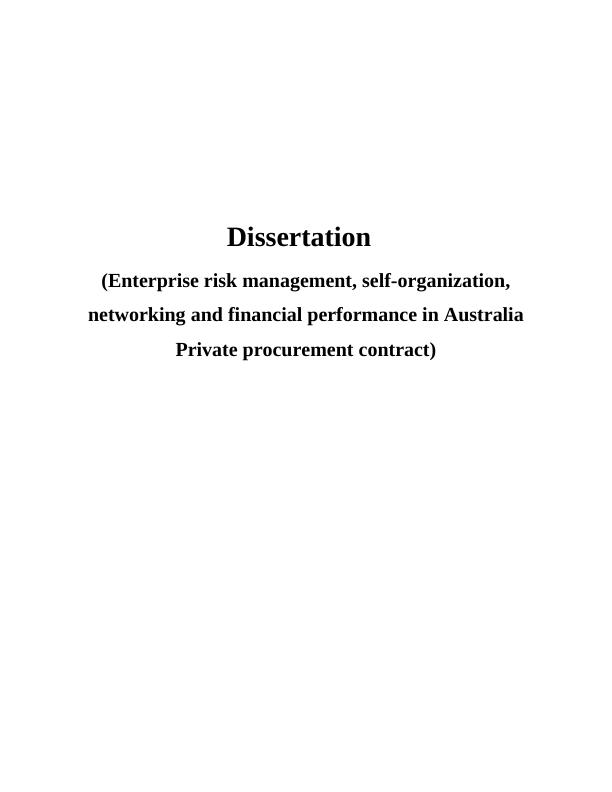
ACKNOWLEDGEMENT
I would like to give a sincere thanks to supervisor for their guidance in completing this
research and for providing required information and direction.
I would also like to give special thanks to Head of Department who supported me in this
project and along with them I would also like to thank institute for providing me opportunity for
this research. I would also like to express gratitude towards friends and peers who helped me in
different ways for completing this research.
I would like to give a sincere thanks to supervisor for their guidance in completing this
research and for providing required information and direction.
I would also like to give special thanks to Head of Department who supported me in this
project and along with them I would also like to thank institute for providing me opportunity for
this research. I would also like to express gratitude towards friends and peers who helped me in
different ways for completing this research.
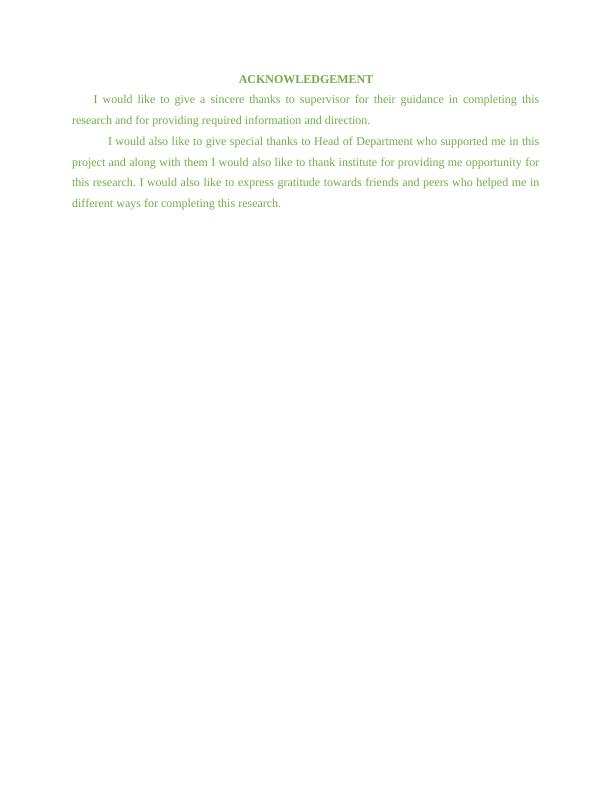
ABSTRACT
Introduction - This study has described about enterprise risk management, self-organization,
networking and financial performance in Australia Private procurement contracts. It has focused
on relationship between ERM, networking with financial performance. Besides that, it is
discussed in depth about ERM and how it plays vital role in procurement contracts.
Methods – The data is gathered from both primary and secondary sources of data in order to
answer research question. Also, sample size chosen from this sample frame is 250 contractors.
Besides that, SPSS analysis is used to determine relationship between ERM, networking and
financial performance. Alongside, anova test and one sample T test, scholar has determined the
association between variables.
Results- It is evaluated that P value obtained is P= .239 which states ongoing activities impact
on self organisation and risk management. Also, P value found is P= 0.00 that shows top
management does not get relevant data and info on managing risk. The P value is .000 so, there
is no significant relationship between intra and inter networking and their role in managing risk.
Discussion- It is discussed hat there is a strong relationship between ERM and financial
performance of an organization. Effective and proper relationship with financial performance can
help an organization in reducing risk associated with financial performance of a business. There
are various kinds of risk management techniques that can be used by organization. Moreover,
organization is required to have a strong relationship between Enterprise risk management and
networking as it helps them to reduce uncertain risk and also improves management of risk.
Conclusion - It is concluded that networking and financial performance are related to one
another. This is because in networking both internal and external stakeholder are there. They are
inter related to each other and form a network. They play vital role in maintaining financial
performance.
Introduction - This study has described about enterprise risk management, self-organization,
networking and financial performance in Australia Private procurement contracts. It has focused
on relationship between ERM, networking with financial performance. Besides that, it is
discussed in depth about ERM and how it plays vital role in procurement contracts.
Methods – The data is gathered from both primary and secondary sources of data in order to
answer research question. Also, sample size chosen from this sample frame is 250 contractors.
Besides that, SPSS analysis is used to determine relationship between ERM, networking and
financial performance. Alongside, anova test and one sample T test, scholar has determined the
association between variables.
Results- It is evaluated that P value obtained is P= .239 which states ongoing activities impact
on self organisation and risk management. Also, P value found is P= 0.00 that shows top
management does not get relevant data and info on managing risk. The P value is .000 so, there
is no significant relationship between intra and inter networking and their role in managing risk.
Discussion- It is discussed hat there is a strong relationship between ERM and financial
performance of an organization. Effective and proper relationship with financial performance can
help an organization in reducing risk associated with financial performance of a business. There
are various kinds of risk management techniques that can be used by organization. Moreover,
organization is required to have a strong relationship between Enterprise risk management and
networking as it helps them to reduce uncertain risk and also improves management of risk.
Conclusion - It is concluded that networking and financial performance are related to one
another. This is because in networking both internal and external stakeholder are there. They are
inter related to each other and form a network. They play vital role in maintaining financial
performance.
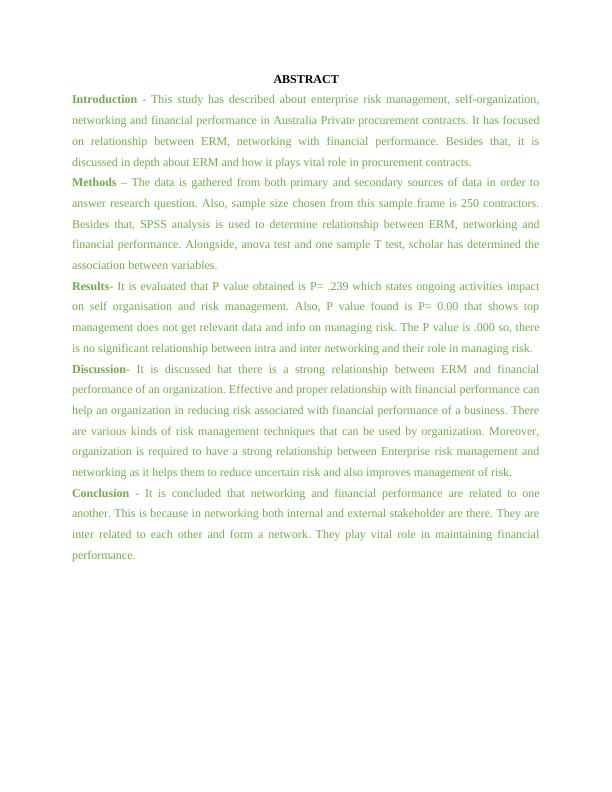
Table of Contents
CHAPTER 1: INTRODUCTION....................................................................................................6
Introduction:....................................................................................................................................6
Overview of research...................................................................................................................6
1.2 Research problem statement:...............................................................................................10
1.3 Justification for research......................................................................................................12
BACKGROUND.............................................................................................................14
AIMS AND OBJECTIVES.............................................................................................17
Research questions...........................................................................................................18
Research hypothesis.........................................................................................................18
1.4 Research methodology.........................................................................................................19
1.5 Outline of research...............................................................................................................19
1.6 Summary of findings...........................................................................................................20
1.7 Definition of key terms........................................................................................................20
1.8 Assumption, delimitation, and justification for the scope of research................................21
1.9 Conclusion...........................................................................................................................21
CHAPTER 2: LITERATURE REVIEW.......................................................................................22
2.0 Introduction..........................................................................................................................22
2.1 Enterprise Risk Management and Financial performance...................................................25
2.2 Enterprise risk management and self-organisation..............................................................30
2.3 Enterprises risk management and networking.....................................................................34
Risk Resilience................................................................................................................35
Risk management in decision making.............................................................................36
2.4 Self-organisation and networking........................................................................................37
2.5 Networking and financial performance...............................................................................40
2.6 Research problem gap..........................................................................................................44
Chapter 3 Hypothesis development...............................................................................................46
CHAPTER 4: RESEARCH METHODOLOGY...........................................................................57
3.0 Introduction..........................................................................................................................58
3.1 Research design...................................................................................................................59
3.2 Area of study........................................................................................................................65
CHAPTER 1: INTRODUCTION....................................................................................................6
Introduction:....................................................................................................................................6
Overview of research...................................................................................................................6
1.2 Research problem statement:...............................................................................................10
1.3 Justification for research......................................................................................................12
BACKGROUND.............................................................................................................14
AIMS AND OBJECTIVES.............................................................................................17
Research questions...........................................................................................................18
Research hypothesis.........................................................................................................18
1.4 Research methodology.........................................................................................................19
1.5 Outline of research...............................................................................................................19
1.6 Summary of findings...........................................................................................................20
1.7 Definition of key terms........................................................................................................20
1.8 Assumption, delimitation, and justification for the scope of research................................21
1.9 Conclusion...........................................................................................................................21
CHAPTER 2: LITERATURE REVIEW.......................................................................................22
2.0 Introduction..........................................................................................................................22
2.1 Enterprise Risk Management and Financial performance...................................................25
2.2 Enterprise risk management and self-organisation..............................................................30
2.3 Enterprises risk management and networking.....................................................................34
Risk Resilience................................................................................................................35
Risk management in decision making.............................................................................36
2.4 Self-organisation and networking........................................................................................37
2.5 Networking and financial performance...............................................................................40
2.6 Research problem gap..........................................................................................................44
Chapter 3 Hypothesis development...............................................................................................46
CHAPTER 4: RESEARCH METHODOLOGY...........................................................................57
3.0 Introduction..........................................................................................................................58
3.1 Research design...................................................................................................................59
3.2 Area of study........................................................................................................................65

3.3 Study population and Sampling Size...................................................................................66
3.4 Sampling Design and Procedure..........................................................................................68
3.5 Data Collection procedures..................................................................................................70
3.6 Sources of data.....................................................................................................................71
3.7 Measurement of variables....................................................................................................74
3.8 Validity and reliability of instrument..................................................................................75
3.9 Data process and analysis....................................................................................................77
3.10 Ethical consideration.........................................................................................................79
3.11 Conclusion.............................................................................................................................81
CHAPTER 5: FINDING AND RESULTS....................................................................................82
4.1 Introduction..............................................................................................................................82
4.2 Overview of data sample.........................................................................................................82
4.3 Descriptive, empirical and qualitative analysis.......................................................................82
4.4 Results from evidence for each research question...................................................................83
4.5 Conclusion.............................................................................................................................154
CHAPTER 6: DISCUSSION, CONCLUSION AND RECOMMENDATION..........................155
5.0 Introduction........................................................................................................................155
5.1 The relationship between Enterprise Risk management and Financial performance........156
5.2 The relationship between Enterprise Risk management and self-organization.................158
5.3 The relationship between Enterprise Risk management and networking..........................159
5.4 The relationship between self-organization and networking.............................................161
5.5 The relationship between Networking and supplier performance.....................................162
5.6 Conclusion.........................................................................................................................164
5.7 Recommendations..............................................................................................................165
5.8 Limitations to the study.....................................................................................................166
5.9 Areas for further research......................................................................................................168
REFERENCES............................................................................................................................169
APPENDIX..................................................................................................................................174
Appendix 1...................................................................................................................................174
3.4 Sampling Design and Procedure..........................................................................................68
3.5 Data Collection procedures..................................................................................................70
3.6 Sources of data.....................................................................................................................71
3.7 Measurement of variables....................................................................................................74
3.8 Validity and reliability of instrument..................................................................................75
3.9 Data process and analysis....................................................................................................77
3.10 Ethical consideration.........................................................................................................79
3.11 Conclusion.............................................................................................................................81
CHAPTER 5: FINDING AND RESULTS....................................................................................82
4.1 Introduction..............................................................................................................................82
4.2 Overview of data sample.........................................................................................................82
4.3 Descriptive, empirical and qualitative analysis.......................................................................82
4.4 Results from evidence for each research question...................................................................83
4.5 Conclusion.............................................................................................................................154
CHAPTER 6: DISCUSSION, CONCLUSION AND RECOMMENDATION..........................155
5.0 Introduction........................................................................................................................155
5.1 The relationship between Enterprise Risk management and Financial performance........156
5.2 The relationship between Enterprise Risk management and self-organization.................158
5.3 The relationship between Enterprise Risk management and networking..........................159
5.4 The relationship between self-organization and networking.............................................161
5.5 The relationship between Networking and supplier performance.....................................162
5.6 Conclusion.........................................................................................................................164
5.7 Recommendations..............................................................................................................165
5.8 Limitations to the study.....................................................................................................166
5.9 Areas for further research......................................................................................................168
REFERENCES............................................................................................................................169
APPENDIX..................................................................................................................................174
Appendix 1...................................................................................................................................174
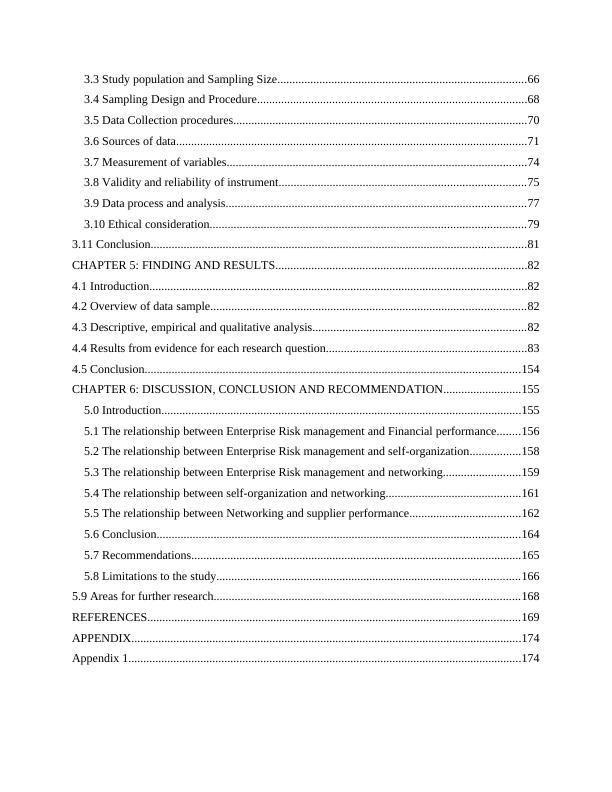
Topic: Enterprise risk management, self-organization, networking and financial performance
in Australia Private procurement contracts 44600
CHAPTER 1: INTRODUCTION
Introduction:
Overview of research
This is the first chapter in the research study which comprises the research topic, aim, objective,
and questions. The chapter starts with the writing of an overview of the research topic and what
the research is all about and what exactly is going to be researched in the following dissertation.
This chapter consists of the background of the study as to what exactly the research is about and
how what is the structure of the whole thesis (Alexander, Gelderblom, & Kock, 2015). This
chapter narrows down the focus and defines the scope of the research. Moreover, the section also
describes the aim and objectives, with the rationale for choosing the specific topic. The
significance of this study is to provide a clear reflect why the study is conducted and assist to
gain knowledge related to the topic. Here, a discussion related to the state of existing research on
the topic is conducted and the relevance of the research is depicted to answer the research issue
in a border way. In this chapter, an overview of the dissertation structure is presented.
In recent times, many businesses are facing critical issues in procurement and due to this, they
are not able to grow and develop. However, the issues are related to quality, price, etc. besides
this, planning and controlling measures are effectively taken to manage risk but private firms can
mitigate impact only to some extent. Nowadays it is required for organizations to maintain
proper communication with internal and external stakeholders because it allows gathering
relevant data and info. In a procurement contract, the major risk is supply chain management.
Sometimes, ineffective supply of materials results in occurring of high risk. Therefore, it changes
the entire context and situation of procurement and the situation also changes due because risk
effect areas according to its degree. Basically, in the supply chain, there are various points or
processes where at the supplier end there is no risk but at companies end risk level is very high
(Berry-Stolzle & Xu, 2016). Similarly, the risk is at the supplier's end but not at companies end.
Along with this the present study will be also work in direction of establishing the impact of the
risk management process of the company over the performance and sustainability of the
company. This is pertaining to the fact that in case the risk within the company will not be
in Australia Private procurement contracts 44600
CHAPTER 1: INTRODUCTION
Introduction:
Overview of research
This is the first chapter in the research study which comprises the research topic, aim, objective,
and questions. The chapter starts with the writing of an overview of the research topic and what
the research is all about and what exactly is going to be researched in the following dissertation.
This chapter consists of the background of the study as to what exactly the research is about and
how what is the structure of the whole thesis (Alexander, Gelderblom, & Kock, 2015). This
chapter narrows down the focus and defines the scope of the research. Moreover, the section also
describes the aim and objectives, with the rationale for choosing the specific topic. The
significance of this study is to provide a clear reflect why the study is conducted and assist to
gain knowledge related to the topic. Here, a discussion related to the state of existing research on
the topic is conducted and the relevance of the research is depicted to answer the research issue
in a border way. In this chapter, an overview of the dissertation structure is presented.
In recent times, many businesses are facing critical issues in procurement and due to this, they
are not able to grow and develop. However, the issues are related to quality, price, etc. besides
this, planning and controlling measures are effectively taken to manage risk but private firms can
mitigate impact only to some extent. Nowadays it is required for organizations to maintain
proper communication with internal and external stakeholders because it allows gathering
relevant data and info. In a procurement contract, the major risk is supply chain management.
Sometimes, ineffective supply of materials results in occurring of high risk. Therefore, it changes
the entire context and situation of procurement and the situation also changes due because risk
effect areas according to its degree. Basically, in the supply chain, there are various points or
processes where at the supplier end there is no risk but at companies end risk level is very high
(Berry-Stolzle & Xu, 2016). Similarly, the risk is at the supplier's end but not at companies end.
Along with this the present study will be also work in direction of establishing the impact of the
risk management process of the company over the performance and sustainability of the
company. This is pertaining to the fact that in case the risk within the company will not be
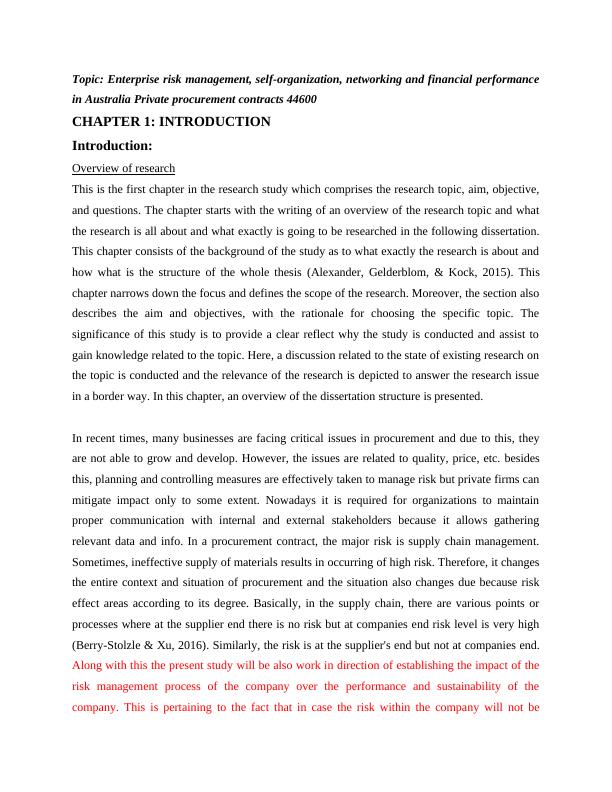
managed then this will affect the working of the company to a great extent. In addition to this the
current study will also outline the fact that the business plays a crucial role within the building
and management of the risk resilience and to determine the management of the natural resources
in order to result in sustainable development. Further the study will also outline the building of
the relationship between the private governance and the private business development along with
the promotion of the innovation by the government through procurement.
Risk management is the process of protecting those value-based areas. Thus, it is essential to
mitigate the impact of risk on that area so that value is aligned. This is because stakeholders are
not involved in measuring risk. However, procurement also faces the problem of risk
identification. It is stated that 8% of procurement organizations have measured risk in the supply
chain. But they have measured it from the external point of view (Lewis, 2001) thus, no proper
measures are taken to protect risk and improve supply chain outcomes. So, to get relevant
outcomes, it is necessary to identify resources from natural risk owners. However, only
determining risk is not beneficial until clear vision, action, etc. the risks are also occurred due to
insufficient info gathered by firms from stakeholders. If businesses are having an improper
network with the suppliers, the government, and with inter departments then there are high
chances of risk. Generally, a strong network of suppliers enables collecting relevant data. Apart
from it, the firm can easily switch from one supplier to another if the high-level risk is identified.
This results in impacting their financial performance. However, business productivity decreases
as well. A network is established through self-organization (Carnovale, Rogers, & Yeniyurt,
2019). So, by following process or methods communication is done and data and information are
shared.
Enterprise risk management (ERM) standpoint, there is a broader disconnect between evaluating
enterprise risk overall versus extending those risk factors in a cohesive manner out to the supply
chain and out to the supply base where contracts are signed that hopefully help mitigate most
supplier risks. ERM frameworks is assess to context in which it is operating which means
understanding the internal risk management environment of a firm and the interest of the
stakeholders (Sweeting, 2017). ERM framework is being defined as the risk management which
involves identification of the particular event relevant to the company. This framework assists
current study will also outline the fact that the business plays a crucial role within the building
and management of the risk resilience and to determine the management of the natural resources
in order to result in sustainable development. Further the study will also outline the building of
the relationship between the private governance and the private business development along with
the promotion of the innovation by the government through procurement.
Risk management is the process of protecting those value-based areas. Thus, it is essential to
mitigate the impact of risk on that area so that value is aligned. This is because stakeholders are
not involved in measuring risk. However, procurement also faces the problem of risk
identification. It is stated that 8% of procurement organizations have measured risk in the supply
chain. But they have measured it from the external point of view (Lewis, 2001) thus, no proper
measures are taken to protect risk and improve supply chain outcomes. So, to get relevant
outcomes, it is necessary to identify resources from natural risk owners. However, only
determining risk is not beneficial until clear vision, action, etc. the risks are also occurred due to
insufficient info gathered by firms from stakeholders. If businesses are having an improper
network with the suppliers, the government, and with inter departments then there are high
chances of risk. Generally, a strong network of suppliers enables collecting relevant data. Apart
from it, the firm can easily switch from one supplier to another if the high-level risk is identified.
This results in impacting their financial performance. However, business productivity decreases
as well. A network is established through self-organization (Carnovale, Rogers, & Yeniyurt,
2019). So, by following process or methods communication is done and data and information are
shared.
Enterprise risk management (ERM) standpoint, there is a broader disconnect between evaluating
enterprise risk overall versus extending those risk factors in a cohesive manner out to the supply
chain and out to the supply base where contracts are signed that hopefully help mitigate most
supplier risks. ERM frameworks is assess to context in which it is operating which means
understanding the internal risk management environment of a firm and the interest of the
stakeholders (Sweeting, 2017). ERM framework is being defined as the risk management which
involves identification of the particular event relevant to the company. This framework assists

the company in assessing them in terms of the likelihood and the magnitude of the impact of the
risk and to determine the response strategy and in addition to this monitoring process. In addition
to this with help of effective identifying and addressing the risk and opportunities and the
business enterprises try to protect the stakeholders and create value for the betterment of the
stakeholders. In addition to this ERM can also be defined as the risk based approach in order to
manage the enterprise in effective manner. The enterprise is being set within the external
environment and there are many different risks which the business may face. Hence, it is very
essential for them to manage these risks in proper and effective manner.
To manage risk, private firms are using many techniques. It has enabled in improving processes
or methods through which risk is managed. Alongside, the major area where risk has occurred is
procurement and due to it, the supply chain is impacted to a great extent. At present time,
organizations are focusing on improving their financial performance because it benefits them in
maintaining growth and development. Also, by analysing data from stakeholders such as
suppliers, investors, customers, etc. (Creswell & Poth, 2018) financial performance is improved,
and the self-organization also plays a significant role. It consists of processor methods that are
used or implemented through self-organization as well financial performance can be improved.
This change is done in the process or new methods are implemented. It enables improving their
efficacy and strengthening networking. With help of it, the operational process is changed, and
proper monitoring is done where the firm develops a new process that supports managing
activities and tasks.
The private firms are not able to maintain financial performance, it may be due to several reasons
or factors. The main reason is a high risk, and it is difficult for businesses to identify risk and
mitigate its impact. Generally, supplier management plays a vital role in the value chain in
procurement. However, the occurrence of risk in many areas is directly integrated with finance.
So, there is a decrease in firm investment and capability to grow and expand. By installing ERM
in procurement risk can be easily identified and then managed. In that strategies are developed to
deal with it. Moreover, there is proper evaluation and auditing of risk provides insight into the
type and degree of risk that can occur. They are: - Credit Risk, it is also called Default Risk.
Credit Risk is related to borrowed money and the amount of risk involved in giving money to the
risk and to determine the response strategy and in addition to this monitoring process. In addition
to this with help of effective identifying and addressing the risk and opportunities and the
business enterprises try to protect the stakeholders and create value for the betterment of the
stakeholders. In addition to this ERM can also be defined as the risk based approach in order to
manage the enterprise in effective manner. The enterprise is being set within the external
environment and there are many different risks which the business may face. Hence, it is very
essential for them to manage these risks in proper and effective manner.
To manage risk, private firms are using many techniques. It has enabled in improving processes
or methods through which risk is managed. Alongside, the major area where risk has occurred is
procurement and due to it, the supply chain is impacted to a great extent. At present time,
organizations are focusing on improving their financial performance because it benefits them in
maintaining growth and development. Also, by analysing data from stakeholders such as
suppliers, investors, customers, etc. (Creswell & Poth, 2018) financial performance is improved,
and the self-organization also plays a significant role. It consists of processor methods that are
used or implemented through self-organization as well financial performance can be improved.
This change is done in the process or new methods are implemented. It enables improving their
efficacy and strengthening networking. With help of it, the operational process is changed, and
proper monitoring is done where the firm develops a new process that supports managing
activities and tasks.
The private firms are not able to maintain financial performance, it may be due to several reasons
or factors. The main reason is a high risk, and it is difficult for businesses to identify risk and
mitigate its impact. Generally, supplier management plays a vital role in the value chain in
procurement. However, the occurrence of risk in many areas is directly integrated with finance.
So, there is a decrease in firm investment and capability to grow and expand. By installing ERM
in procurement risk can be easily identified and then managed. In that strategies are developed to
deal with it. Moreover, there is proper evaluation and auditing of risk provides insight into the
type and degree of risk that can occur. They are: - Credit Risk, it is also called Default Risk.
Credit Risk is related to borrowed money and the amount of risk involved in giving money to the

End of preview
Want to access all the pages? Upload your documents or become a member.
Related Documents
Enterprise Risk Management, Self-Organization, Networking, and Financial Performance in Australia Private Procurement Contractlg...
|49
|20756
|55
Impact of Employee Motivation on Organizational Performance in McDonaldslg...
|100
|22482
|61
Enterprise Risk Management - PDFlg...
|28
|11962
|45
Influence of Digital Technology on Fashion Retail Managementlg...
|39
|10681
|97
Report on Effectiveness of Recruitment Practiceslg...
|74
|13560
|43
Impact of Soft Skills Training on Manager's Performance in Retail Organizationlg...
|58
|22146
|68
